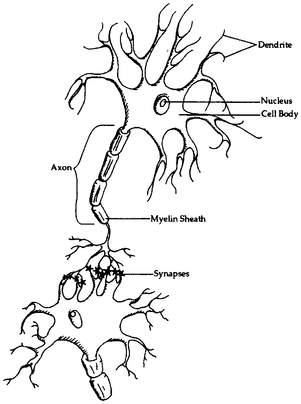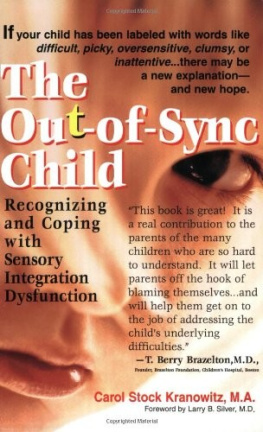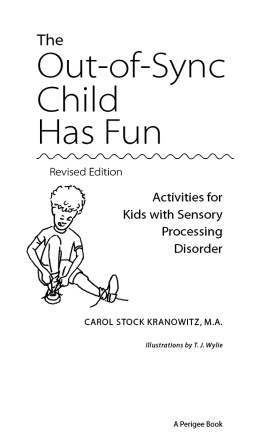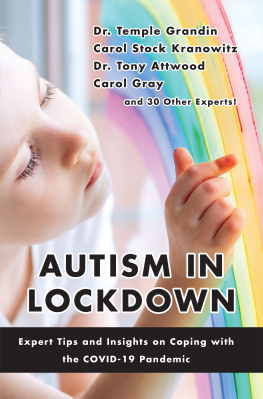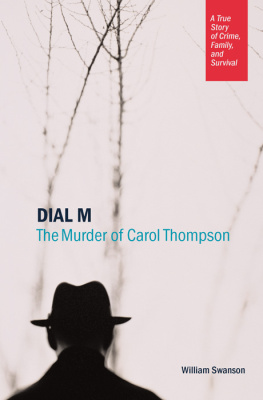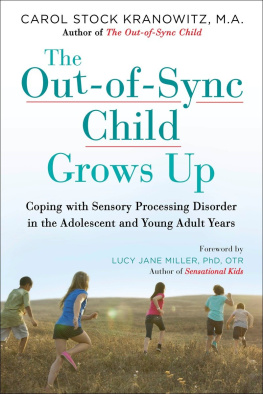ACKNOWLEDGMENTS
Primarily, I am profoundly grateful to the late A. Jean Ayres, PhD, OTR, whom I never met but shall revere forever. Her work has touched and moved me to do all I can for children with sensory problems.
I also thank all those who made the first edition of this book possible:
Occupational therapists Lynn A. Balzer-Martin, Georgia deGangi, Sheri Present, Susanne Smith Roley, and Trude Turnquist.
Early childhood specialists and advocates T. Berry Brazelton, Barbara Browne, Donna Carter, Michael Castleberry, Elizabeth Dyson, Stanley Greenspan, Jane Healy, Anne Kendall, Jack Klein mann, Patricia Lemer, Larry Silver, and Karen Strimple.
SI parents Chris Bridgeman, Catherine and Ron Butler, Deborah Thommasen, Linda Finkel and Vivek Talvadkar, Jacquie and Paul London, Mary Eager, and Denise McMillen.
Teachers and students at St. Columbas Nursery School in Washington, DC; Lynn Sonberg and Meg Schneider of Skylight Press; Sheila Curry Oakes, my first Perigee editor; T.J. Wylie, illustrator; and my family.
For this second edition, my everlasting love and thanks go to Lucy Jane Miller, PhD, OTR, FAOTA, who has gently guided my thinking and raised my level of understanding about sensory processing. Additionally, I thank these marvelous professionals for their wisdom and support:
Occupational therapists Marie Anzalone, Paula Aquilla, Erna Blanche, June Bunch, Anita Bundy, Sharon Cermak, Ellen Cohn, Valerie Dejean, Marie DiMatties, Winnie Dunn, Anne Fisher, Sheila Frick, Kimberly Geary, Tara Glennon, Barbara Hanft, Anne Henderson, Diana Henry, Lois Hickman, Jan Hollenbeck, Catherine Hostetler, Genevieve Jereb, Lorna Jean King, Nancy Kashman, Moya Kinnealey, Jane Koomar, Lawrene Kovalenko, Aubrey Lande, Shelly Lane, Barbara Lindner, Zoe Mailloux, Teresa May-Benson, Heather Miller-Kuhaneck, Myania Moses, Elizabeth Murray, Patricia Oetter, Beth Osten, Diane Parham, Charlane Pehoski, Norma Quirk, Sharon Ray, Judith Reisman, Eileen Richter, Roseann Schaaf, Colleen Schneck, Sherry Shellenberger, Jill Spokojny Guz, Janet Stafford, Shirley Sutton, Stacey Szklut, Sandy Wainman, Rondalyn Whitney, Julia Wilbarger, Patricia Wilbarger, Sue Wilkinson, Mary Sue Williams, and Ellen Yack.
Developmental optometrists Sanford Cohen, Kenneth Lane and Charles Shidlofsky; Nutritionist Kelly Dorfman; Physicians Fernette and Brock Eide; Psychologist Sharon Heller; Speech language pathologists Laura Glaser, Joanne Hanson, Janet Mora and Kathleen Morris; other influential individuals including Julie Starbuck, Temple Grandin, Stephen Shore, the Pfefferle family, David Brown, Mark Zweig, and my current editor at Perigee, Marian Lizzi.
I am eternally in your debt.
Carol Kranowitz
Bethesda, Maryland
Summer, 2005
APPENDIX A: THE SENSORY PROCESSING MACHINE
Here is a brief anatomy lesson about the central nervous system, and an explanation of how sensory processing occurs therein. This overview may help you appreciate the marvel of the brain-and-body connection.
THE SYNCHRONIZED NERVOUS SYSTEM
All animals respond to sensations of touch, movement and gravity, and body position. Thus, human animals share the hidden senses with goldfish and goats, falcons and frogs, caterpillars and clams. Through eons of evolution, humankind refined these senses in order to survive in a hazardous world.
As life forms gradually arose from sea to land to treetops, they had to adapt to differing environments. Hands to pluck berries, limbs to climb trees, eyes to see moving as well as stationary objects, and ears to detect prey and predators developed over time.
Along with these skills came increasingly complex sensations. The human brain evolved to process these sensations, so that the hand would pick a berry rather than a thorn, the limb would cling to a branch, the eye would discern a motionless tiger poised to pounce, and the ear would hear faraway hoof beats.
With the most complex brain in the animal kingdom, humans have the most complex nervous system. Its main task is to process sensations.
The nervous system has three main parts, working in harmony. One is the peripheral nervous system, running through organs and muscles, such as the eyes, ears, and limbs. The second part is the autonomic nervous system, controlling involuntary functions of heart rate, breathing, digestion, and reproduction. The third part,is the central nervous system (CNS), consisting of countless neurons, a spinal cord, and a brain.
THREE COMPONENTS OF THE CENTRAL NERVOUS SYSTEM
A) The Neurons
Neurons, or nerve cells, are the structural and functional units of the nervous system. Neurons tell us what is happening inside and outside our bodies. The brain has approximately 100 billion neurons. Each neuron has:
A cell body, with its nucleus inside.
Many short dendrites (Greek for little branches) reaching out to other neurons to receive messages, or impulses, and carrying them into the cell body.
A long axon, like a stem with roots, which sends impulses from the cell body to the dendrites of other neurons.
A Neuron
Two kinds of neurons connect the brain and spinal cord to the rest of the body: sensory and motor. Sensory neurons receive impulses from sensory receptors in our eyes, ears, skin, muscles, joints, and organs.
Impulses travel along the sensory neurons axon and communicate messages to other neurons at contact points called synapses (Greek for point of juncture). Each neuron makes thousands of synaptic connections every time it fires. The neuron firing off the message is called presynaptic; the neuron receiving the message is called postsynaptic.
At the nanosecond that the message is fired, neurotransmitters are released, causing an electrochemical response. When neurotransmitters activate the receptors of the postsynaptic neurons, they are called excitatory. When they do not activate receptors, they are called inhibitory. (The process of balancing excitatory and inhibitory messages is called modulation. See p. 57)
The postsynaptic neurons may be other sensory neurons, or they may be motor neurons, the second kind of neurons in our CNS. Receiving the information, the motor neurons instruct muscles to move, glands to sweat, lungs to breathe, intestines to digest, and other body parts to respond appropriately.
In the growing fetus, neurons and synaptic connections multiply rapidly. A baby is born with billions of neurons and trillions of synapses. Sensations of smell, touch, and hunger activate synaptic connections to help the baby survive. For instance, synaptic connections help him respond to a nipple so he can suck.
To help the baby respond efficiently to this early skill of sucking, as well as to more complex skills, a process called myelination occurs. Myelin is a substancesomewhat like an electrical insulatorthat coats the axon of the neuron to protect it, to smooth the path, and to speed up the connections.
At about eighteen months, the child stops developing new neurons, because his brain already has all that it needsand his skull has all that will fit! New synapses, however, keep multiplying as the child integrates new sensations. That is, synapses multiply if synaptic connections are useful for everyday functioning and if they are repeatedly used. Otherwise, they vanish.
By about twelve years, the child will lose many synapses he was born with, through a normal and necessary process called pruning. Pruning eliminates synapses the child does not need and stabilizes those he does. If he is Japanese, his brain will prune synapses necessary to pronounce the sound of r, because r isnt used in his language. If he is French, his brain will strengthen these synapses, so he can roll an r with fluency.
